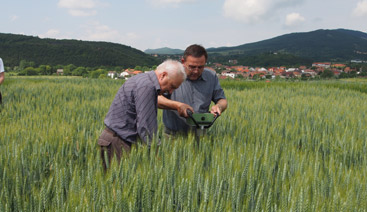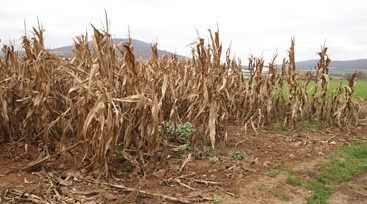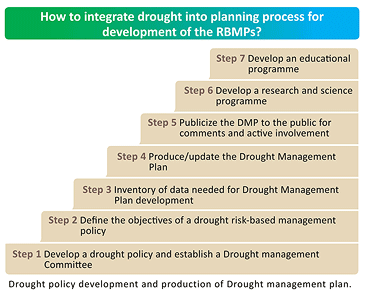Danube Watch 2/2016 - From reactive to proactive drought management
From reactive to proactive drought management
The need for regional and national drought policies has prompted the Global Water Partnership and the World Meteorological Organisation to create seven-step guidelines to support authorities responsible for national drought planning in Central and Eastern Europe.

As part of an IDMP CEE demonstration project on measures to increase soil water-holding capacity in June 2014, experts estimate soil compaction with a soil penetrometer at the experimental field of Slovak University of Agriculture in Kolinany.
© GWP CEE/Majercakova
Countries in Central and Eastern Europe are sensitive to variability and changing precipitation patterns when managing water resources and adapting to climate change. Furthermore, future climate scenarios in the region forecast increased frequency and severity of extreme weather events, which will result in an increase of droughts. Each time a drought occurs, many of the same issues are raised in the region, such as: How much damage was inflicted, on whom, and where? Who is going to pay for it? How can we prevent, or at least reduce damages and their costs in the future?
From reactive to proactive drought management. In 2013, the Global Water Partnership (GWP) and World Meteorological Organization (WMO) launched the joint Integrated Drought Management Programme (IDMP) to improve the monitoring and prevention of droughts. In the same year, the IDMP was launched at the regional level for Central and Eastern Europe (IDMP CEE). The IDMP CEE aims to support stakeholders at all levels by providing policy and management guidance and by sharing scientific data and best practices for integrated drought management. During Phase 1 of the IDMP CEE, the overall drought situation was analysed in the ten CEE countries of Bulgaria, Czech Republic, Hungary, Lithuania, Moldova, Poland, Romania, Slovakia, Slovenia, and Ukraine. The results confirmed that drought and water scarcity issues were widely recognised as a relevant phenomenon in the CEE region.
The IDMP CEE focuses mainly on current gaps in the implementation of the EU Water Framework Directive (WFD). One of the WFD requirements for a River Basin Management Plan is to develop a Drought Management Plan as a supplementary measure, in case obligatory measures are not sufficient to avoid water scarcity. This was not pursued in the participating CEE countries. “Without coordinated national drought policies, nations will continue to respond to drought in a reactive way," says Michel Jarraud, Secretary-General of the World Meteorological Organization.
Therefore, the IDMP CEE aimed to develop Guidelines as a support tool for public bodies and authorities to prepare Drought Management Plans in each participating country. The IDMP CEE Guidelines use a step-by-step approach to develop Drought Management Plans in accordance with WMO/GWP Guidelines and EU Guidelines.

Extreme droughts cause economic losses, ecological damage and threats to human health. The Integrated Drought Management programme was launched at the regional level for Central and Eastern Europe to provide policy and management guidance and to share best practices for integrated drought management.
© GWP CEE/Majercakova
The objective of the Guidelines. The general objective of the Guidelines is to support the timely production of national Drought Management Plans within the development of the River Basin Management Plans. In addition, the Guidelines encourage broader commitments to integrated water management systems, according to the WFD, that provide a better understanding of how to integrate drought management into the planning and development of River Basin Management Plans. What’s more, the Guidelines provide information on other issues related to drought that are included in the WFD, such as quantitative status, prolonged drought and climate change.
The Guidelines can help shape the integration of vertical planning and decision- making processes at different levels using a multi-stakeholder approach, including thre key sectors agriculture, energy, tourism and others. “Reflecting the regional conditions of Central and Eastern Europe, the Guidelines present seven clear steps on how to prepare the drought management plan in a participatory way," says Richard Müller, GWP CEE Regional Coordinator.
To date the Guidelines have been translated into six Central and Eastern European languages – Hungarian, Lithuanian, Slovak, Slovenian, Romanian and Ukrainian.
A bottom-up approach. An essential part of IDMP CEE was involving the main end-users at the policy level through conducting more than 20 national consultation dialogues in ten countries. The main purpose of the dialogues was to discuss the current status of drought management in the country, the strong and weak areas, and how IDMP CEE results could be used at the national level to help improve all aspects of drought management. The first round of dialogues opened a discussion among key actors in each country dealing with drought issues at multiple levels including for policy makers (ministries, state agencies); professionals (hydrometeorological services, universities); and stakeholders (farmers, households, energy companies, fisheries, and others).
The second round of dialogues aimed to gather national practical experiences and other information relevant to drought planning, and to give comments, corrections, suggestions, and amendments to the draft guidelines according to the specific conditions and drought planning experiences of countries.
In some countries, a third round of dialogues was organised, where stakeholders had the chance to provide feedback on the Guidelines and to look for further steps to take for planning in the country. “We believe the National Consultation Dialogues and the Guidelines helped strengthen the cross-sectorial cooperation in most countries and will ensure the participation of interested stakeholders in the preparation of Drought Management Plans," says Sabina Bokal, IDMP CEE Programme Manager.

Based on well-known approaches from EU and GWP/
WMO guidelines, a team of experts developed seven steps
– specific to Central and Eastern European countries – to
be used by public bodies and authorities responsible for
national drought planning.
© IDMP CEE
The Guidelines for preparing the Drought Management Plans can be downloaded at www.gwpcee.org.






